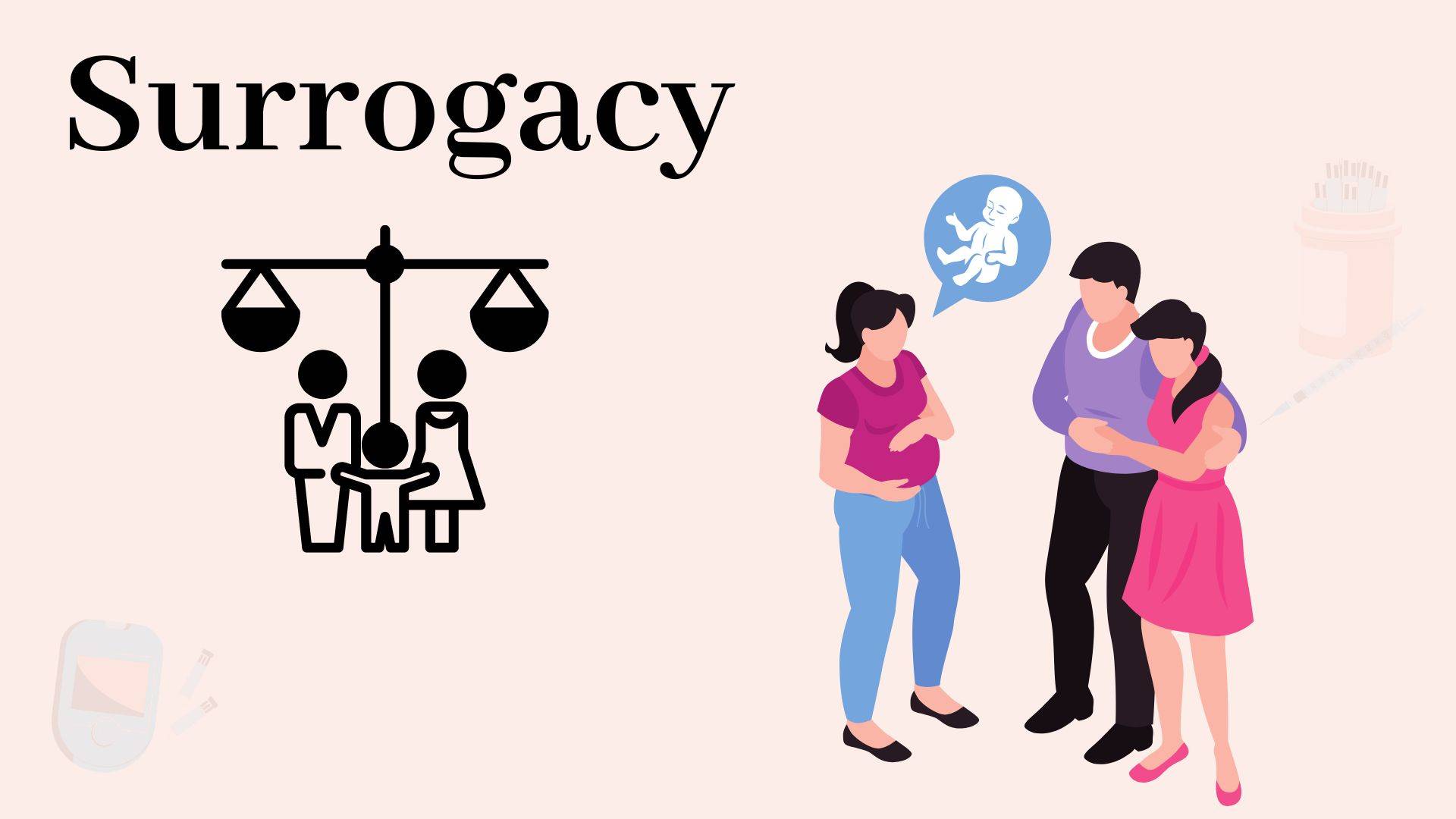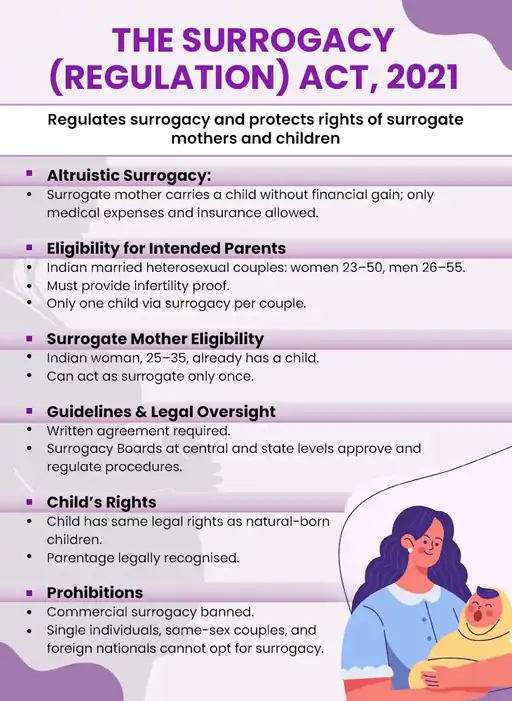Context:
In a landmark judgment on October 9, 2025, the Supreme Court of India ruled that the age restrictions introduced under the Surrogacy (Regulation) Act, 2021 would not apply to couples who had frozen embryos before the law came into effect. The Bench, comprising Justices B.V. Nagarathna and K.V. Viswanathan, held that couples who had initiated the surrogacy process before the Act’s enforcement could not be denied the right to parenthood merely due to new statutory limits.
-
- The Court observed that the right to reproductive choice, including the decision to have a child through surrogacy, is an integral part of personal liberty and privacy under Article 21 of the Constitution. This judgment balances the intent of the law—to prevent commercial exploitation—with the constitutional right of individuals to make reproductive decisions.
- The Court observed that the right to reproductive choice, including the decision to have a child through surrogacy, is an integral part of personal liberty and privacy under Article 21 of the Constitution. This judgment balances the intent of the law—to prevent commercial exploitation—with the constitutional right of individuals to make reproductive decisions.
Understanding the Surrogacy (Regulation) Act, 2021:
Enacted alongside the Assisted Reproductive Technology (Regulation) Act, 2021, the Surrogacy Act provides a comprehensive framework for ethical surrogacy in India.
The primary goal of these laws is to regulate surrogacy procedures, prevent exploitation, and prohibit commercial surrogacy, which had earlier become a multi-million-dollar industry often accused of commodifying women’s reproductive labour.
Key Features of the Act:
-
- Type of Surrogacy Allowed:
- Type of Surrogacy Allowed:
Only altruistic surrogacy is permitted, where the surrogate mother does not receive monetary compensation beyond medical expenses and insurance coverage.
Commercial surrogacy, involving payment or profit, is strictly banned and punishable.
-
- Eligibility Criteria for Couples:
- Only Indian married couples can avail of surrogacy.
- The wife must be aged 23–50 years, and the husband 26–55 years.
- The couple must not have a surviving biological or adopted child.
- A certificate of essentiality and certificate of eligibility must be obtained before proceeding.
- Only Indian married couples can avail of surrogacy.
- Eligibility for Surrogate Mother:
- Must be a married woman aged 25–35 years with at least one child of her own.
- Can act as a surrogate only once and cannot use her own gametes.
- Must be a married woman aged 25–35 years with at least one child of her own.
- Parental Rights:
- Eligibility Criteria for Couples:
The child born through surrogacy is legally and biologically deemed the child of the intending couple, entitled to all rights of a natural-born child.
-
- Regulatory Mechanisms:
- Establishment of the National and State Surrogacy Boards (NSB & SSB) to supervise clinics and enforce ethical standards.
- Only registered surrogacy clinics may perform procedures.
- Strict penalties for commercial surrogacy, exploitation, or sale of embryos, with imprisonment up to 10 years and fines up to ₹10 lakh.
- Establishment of the National and State Surrogacy Boards (NSB & SSB) to supervise clinics and enforce ethical standards.
- Regulatory Mechanisms:
Types of Surrogacy and Key Concepts:
1. Traditional Surrogacy: The surrogate uses her own egg, fertilised with the intended father’s sperm, making her the biological mother. This method is not legally permitted in India.
2. Gestational Surrogacy: The surrogate carries an embryo created through IVF using the gametes of the intending couple or donors. The child shares no genetic link with the surrogate, which is the only permitted form under Indian law.
3. Altruistic vs. Commercial Surrogacy:
o Altruistic surrogacy is based on compassion or kinship, without profit.
o Commercial surrogacy, previously common in India, involved payments to the surrogate and is now illegal due to ethical and human rights concerns.
Why the Law Was Introduced:
India was once dubbed the “surrogacy capital of the world,” attracting many foreign couples due to lower costs and lenient regulations. However, reports of exploitation, unsafe medical practices, and legal uncertainties prompted the government to step in.
The 2021 Act was thus enacted to:
-
- Protect women from exploitation and trafficking.
- Ensure medical and legal safeguards.
- Prevent the commodification of childbirth.
- Restrict the practice to Indian couples facing genuine infertility.
- Protect women from exploitation and trafficking.
Arguments Before the Supreme Court:
Petitioners’ Arguments:
-
-
- The couples argued that they had a vested right to proceed with surrogacy since they had frozen embryos before the law came into force.
- Applying age restrictions retrospectively violated Article 14 (equality before law) and Article 21 (right to life and personal liberty).
- They contended that reproductive autonomy—the right to decide when and how to have children—is a fundamental aspect of personal liberty.
- They also challenged the exclusion of unmarried single women, calling it arbitrary and discriminatory.
- The couples argued that they had a vested right to proceed with surrogacy since they had frozen embryos before the law came into force.
-
Government’s Arguments:
-
-
- The Centre maintained that the age limits were medically justified, based on expert recommendations.
- It argued that surrogacy is not a fundamental right, but a statutory privilege subject to regulation.
- The transitional clause (Section 53) was designed only to protect existing surrogate mothers, not couples with frozen embryos.
- The government also cited concerns about health risks associated with advanced parental age and the well-being of the child.
- The Centre maintained that the age limits were medically justified, based on expert recommendations.
-
Supreme Court’s Observations:
-
- The Court disagreed with the government’s narrow interpretation and ruled that the law could not operate retrospectively unless explicitly stated. It observed that a new law should regulate future actions, not past ones. Couples who had already initiated the surrogacy process before the law came into effect could not be denied parenthood merely because of the new age restrictions.
- The Bench emphasised that the intent of the Act was to curb commercial surrogacy, not to obstruct genuine cases of parenthood. It also questioned why surrogacy should be denied to older couples willing to take the same risks as those associated with natural late-age pregnancies.
- The Court further clarified that the transitional provision under Section 53 could not be interpreted in a way that nullifies existing rights. The rights of intending couples who had already created embryos before the law’s commencement were held to remain valid and unaffected by the new statutory limits.
- The Court disagreed with the government’s narrow interpretation and ruled that the law could not operate retrospectively unless explicitly stated. It observed that a new law should regulate future actions, not past ones. Couples who had already initiated the surrogacy process before the law came into effect could not be denied parenthood merely because of the new age restrictions.
Significance of the Judgment:
-
- Reinforces Reproductive Autonomy: The ruling affirms that reproductive choice, including surrogacy, is an essential facet of personal liberty and privacy under Article 21.
- Ensures Fair Transition: The Court’s interpretation introduces a “grandfather clause” principle, protecting couples already in process when new regulations come into effect.
- Sets a Precedent on Legislative Fairness: The judgment upholds the principle that laws should not operate retrospectively to take away vested rights, unless explicitly provided.
- Balances Regulation with Compassion: By distinguishing between exploitative commercial surrogacy and genuine parenthood, the Court underscores the human dimension of reproductive rights.
- Reinforces Reproductive Autonomy: The ruling affirms that reproductive choice, including surrogacy, is an essential facet of personal liberty and privacy under Article 21.
Challenges and Ethical Concerns Ahead:
Despite the progressive ruling, the surrogacy ecosystem in India still faces several challenges:
-
- Exclusion of Unmarried and LGBTQ+ Individuals:
- Exclusion of Unmarried and LGBTQ+ Individuals:
The current law restricts surrogacy to married heterosexual couples, leaving out single parents and same-sex couples.
-
- Ambiguity in Parental Rights and Citizenship:
- Ambiguity in Parental Rights and Citizenship:
Children born through surrogacy, especially involving donor gametes, often face legal uncertainties over parentage and nationality.
-
- Health and Emotional Support for Surrogates:
- Health and Emotional Support for Surrogates:
Even in altruistic arrangements, surrogates need access to medical, psychological, and social support to ensure their well-being.
-
- Need for Greater Awareness and Regulation:
- Need for Greater Awareness and Regulation:
Clearer guidelines and public education are essential to eliminate stigma and prevent misuse of assisted reproductive technologies.
Conclusion:
The Supreme Court’s decision in October 2025 is a milestone in India’s evolving reproductive rights jurisprudence. It reaffirms that while the state has the authority to regulate medical practices, it cannot override individual autonomy and dignity.
| UPSC/PCS Main Question: |








